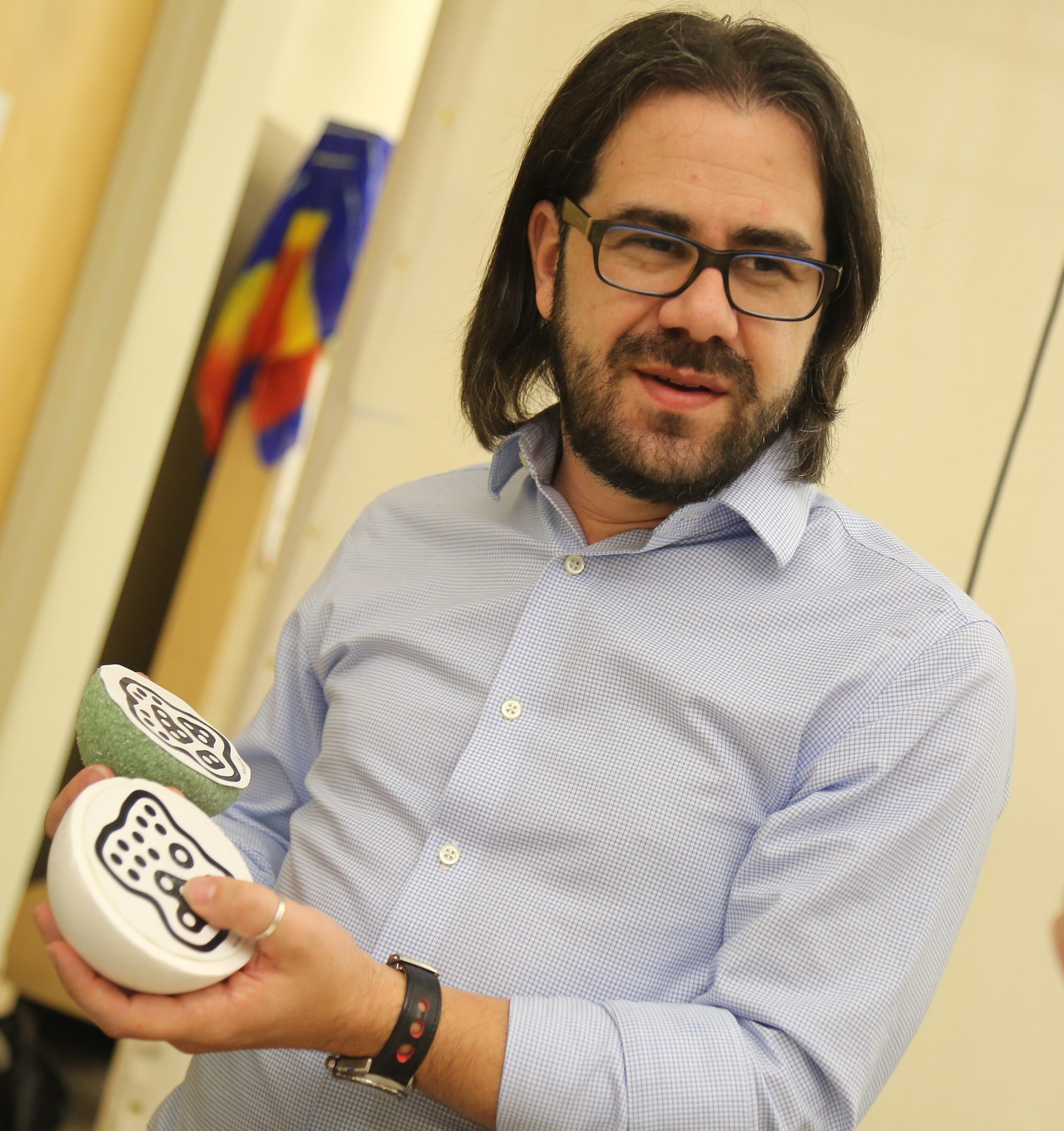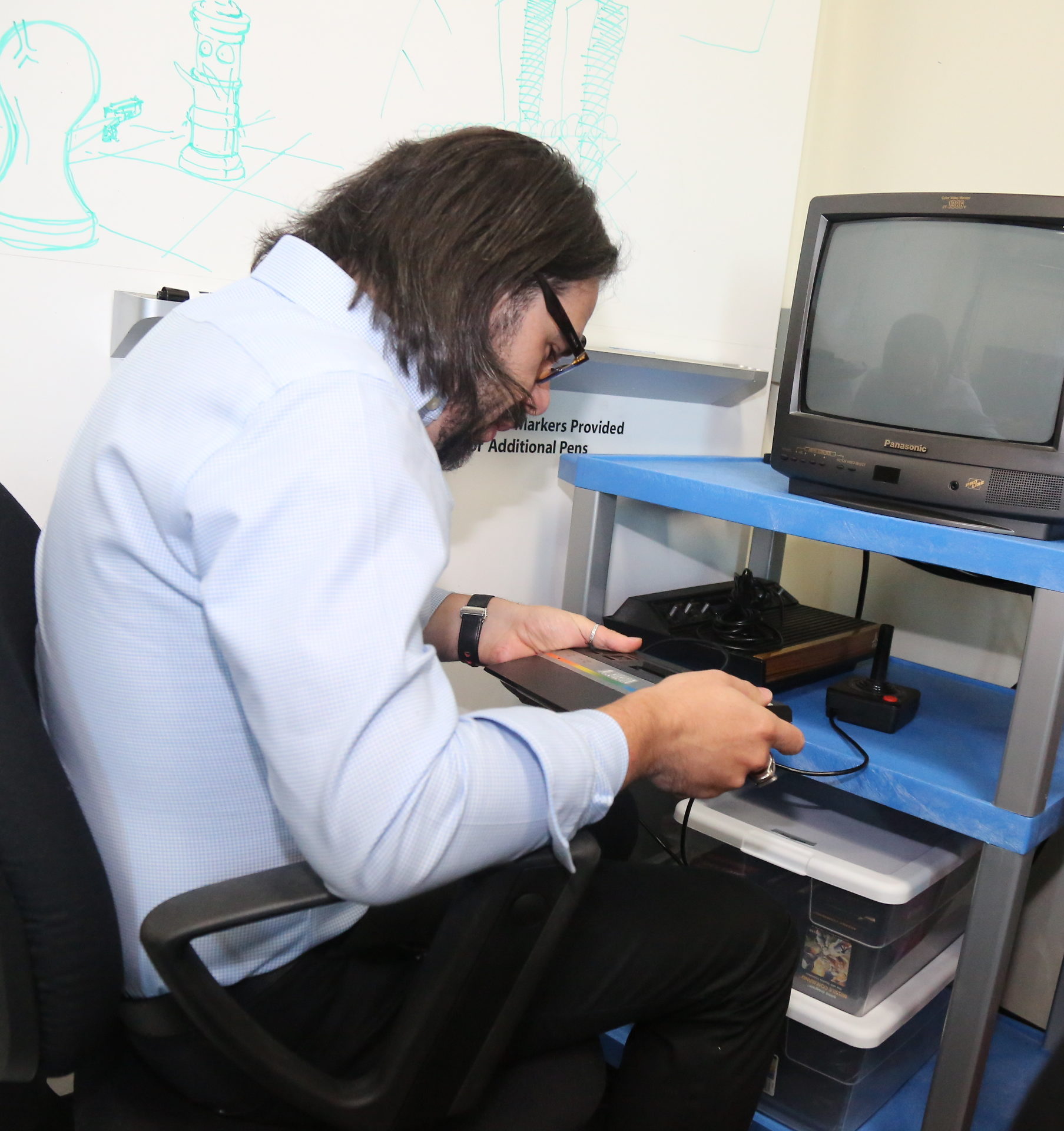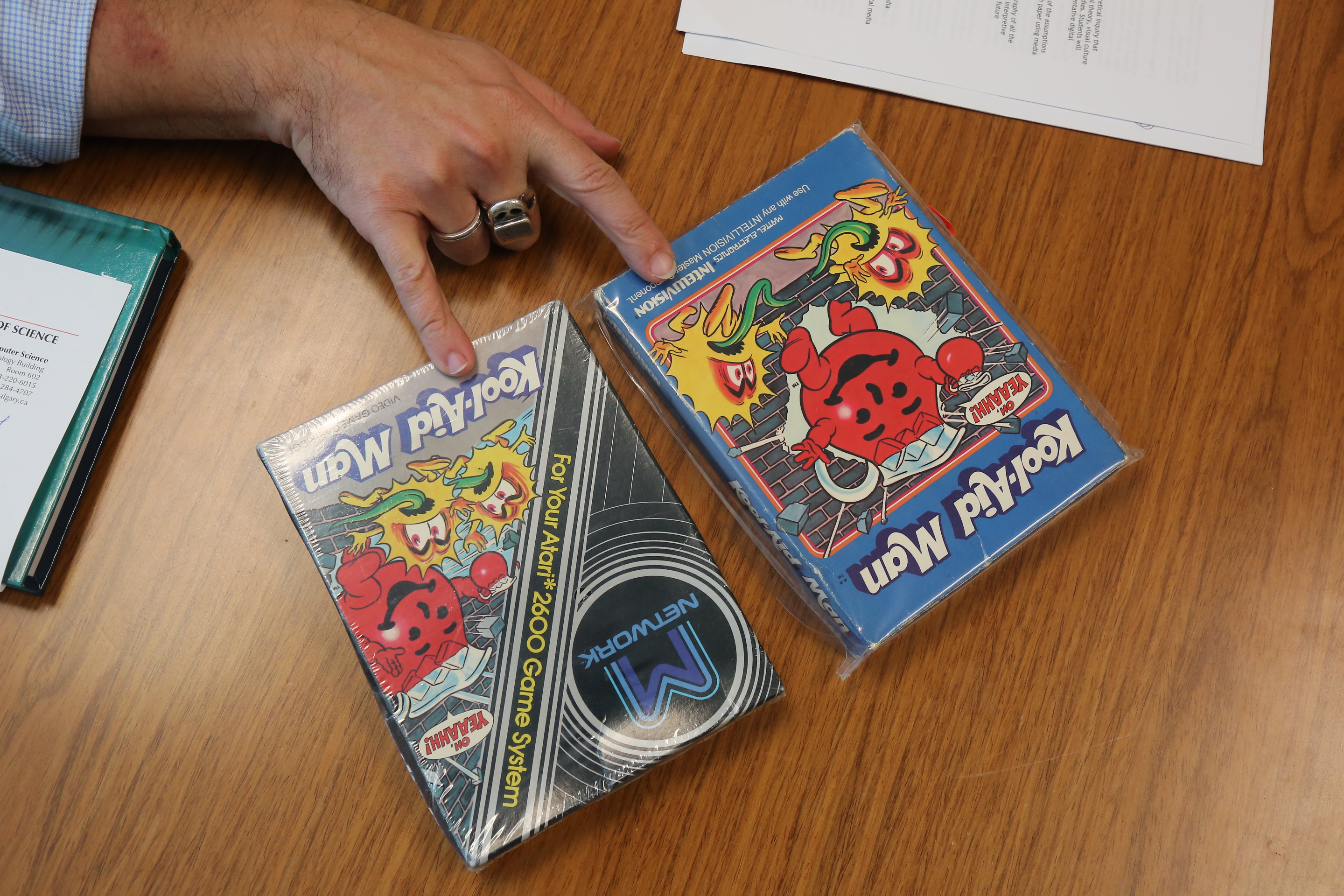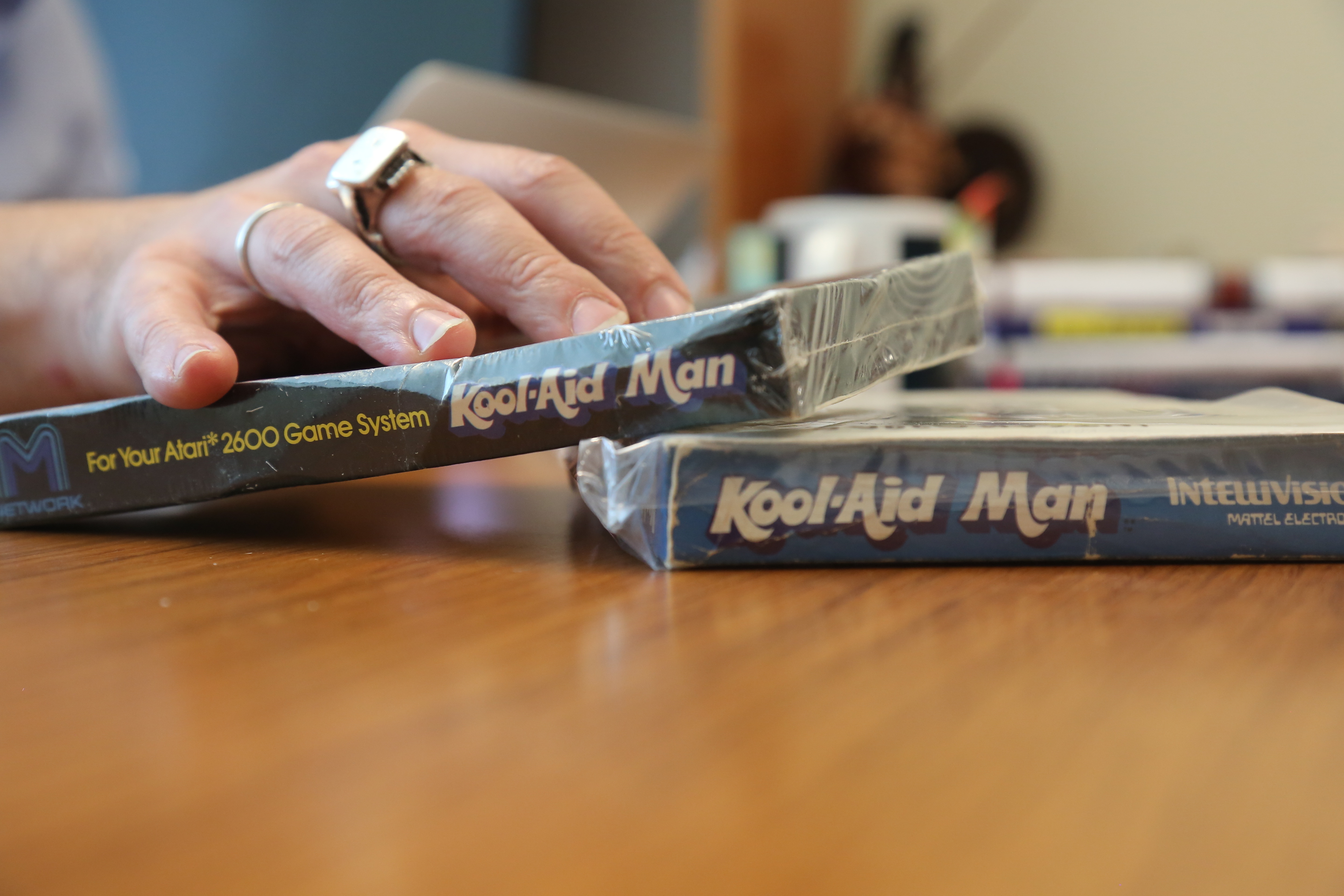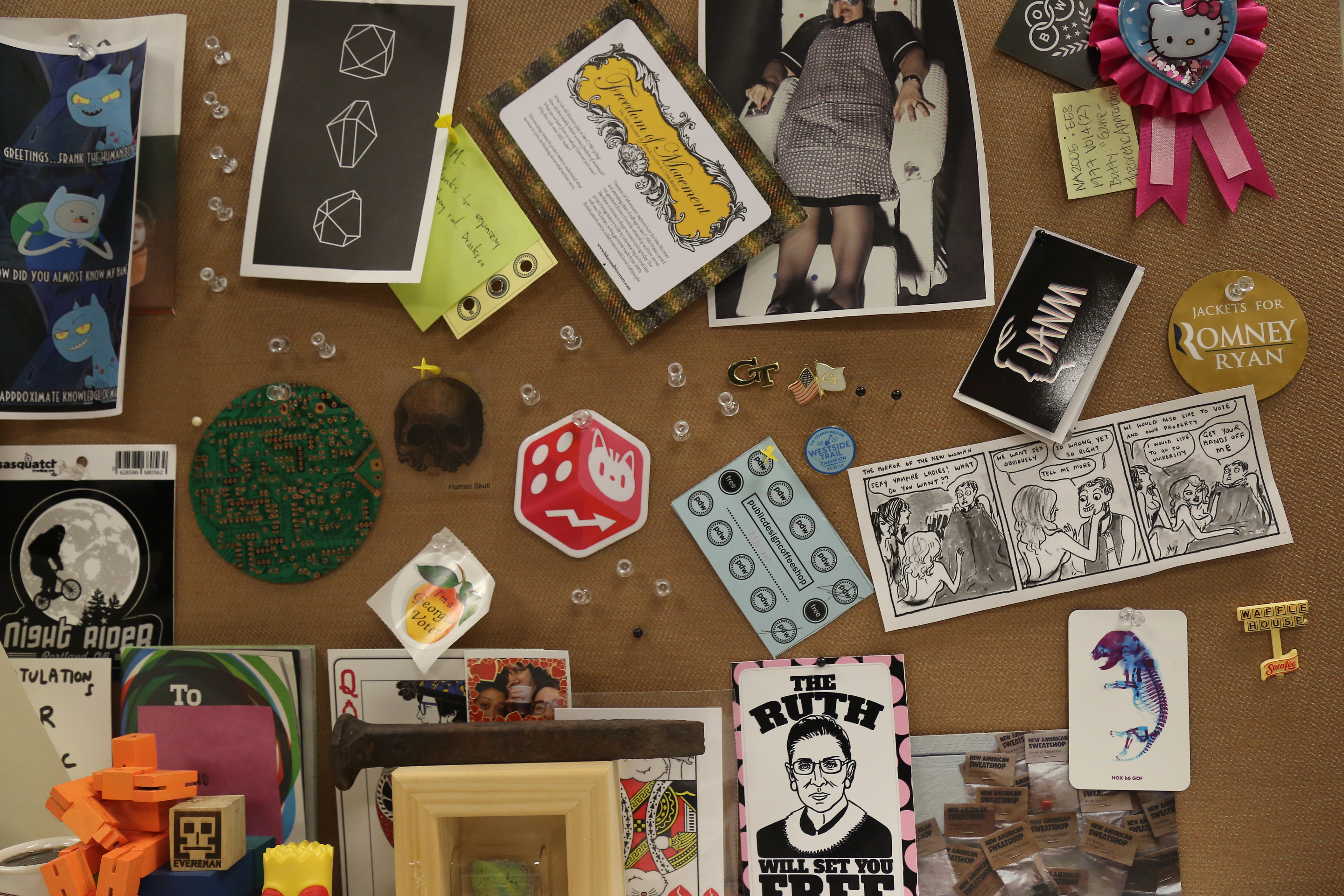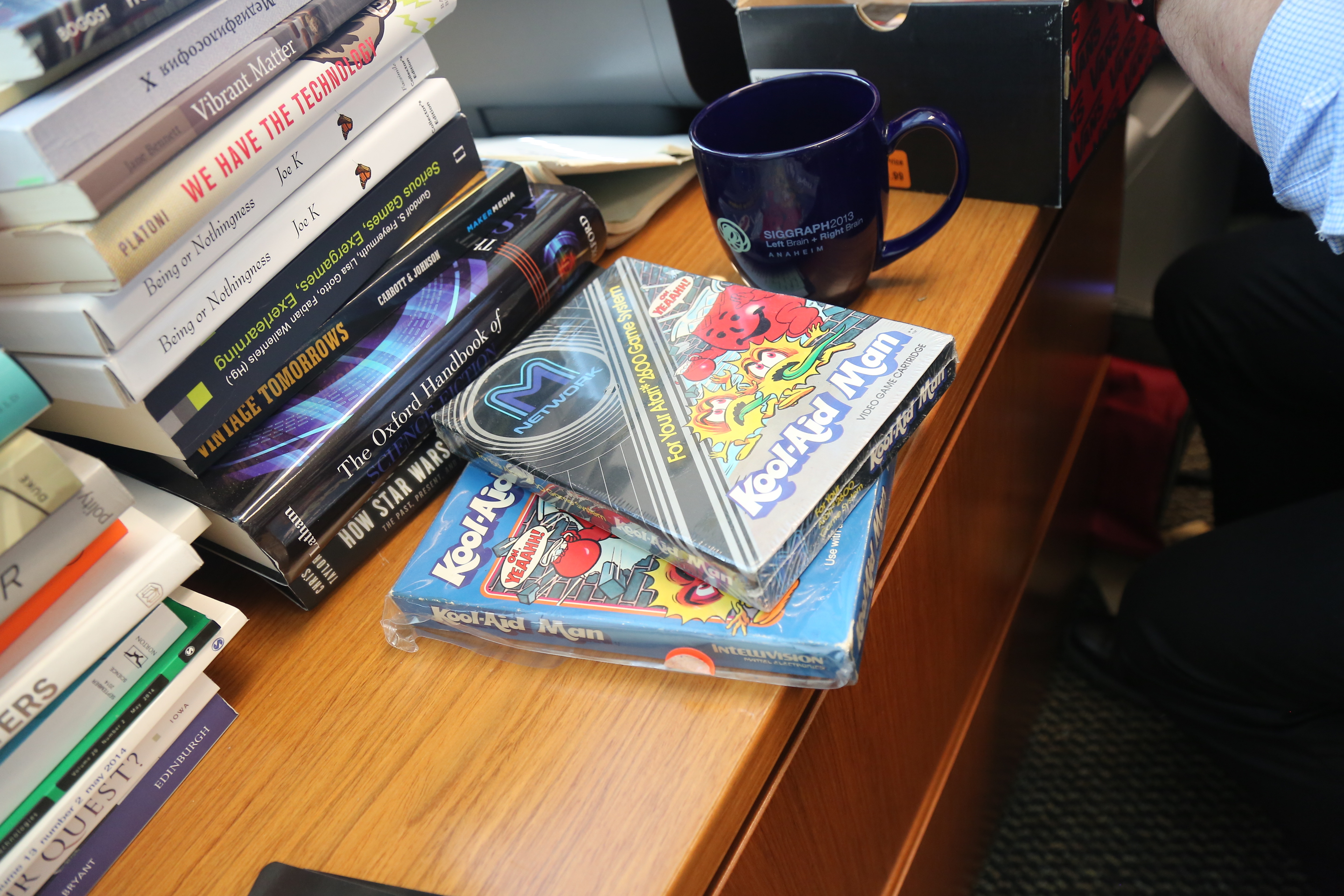Irony & Loss
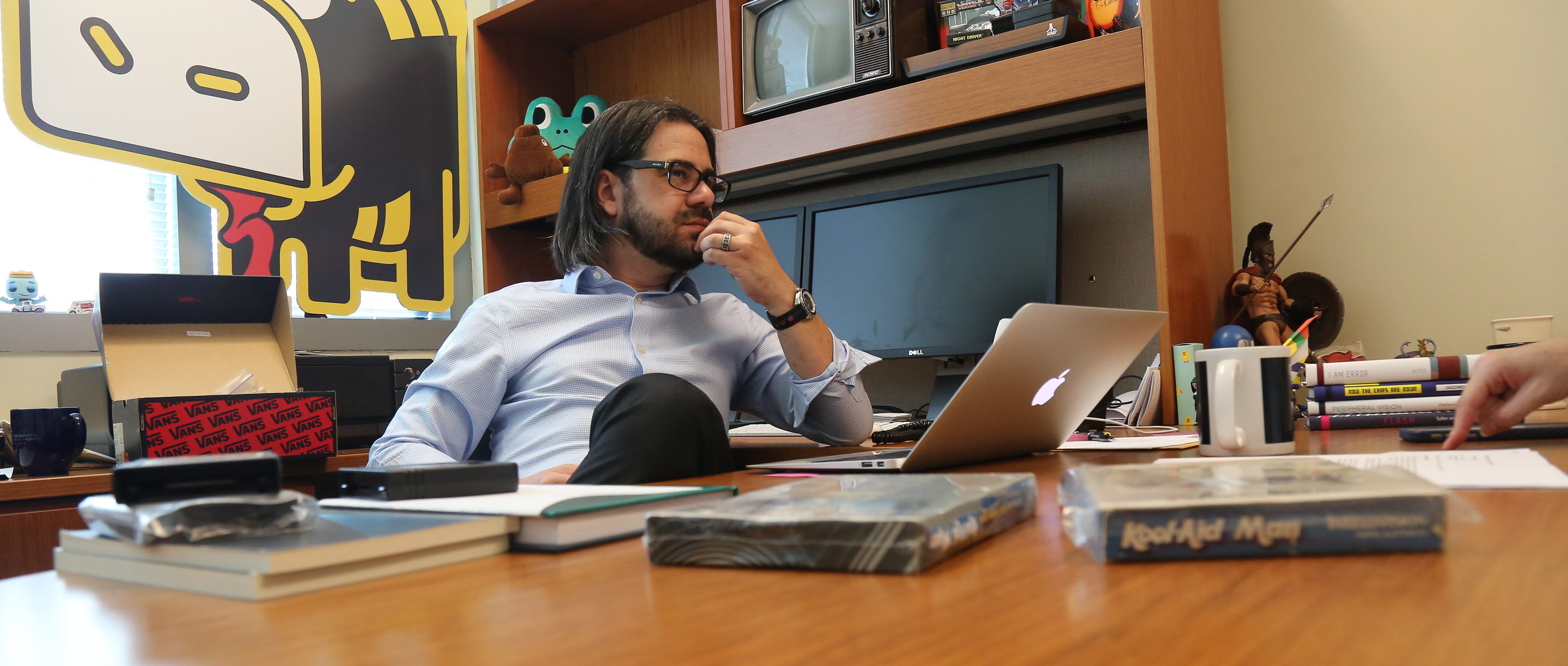
All images: Brandon English, 2016
Share:
With his new book, Play Anything: The Pleasure of Limits, the Uses of Boredom, and the Secret of Games (Basic Books, 2016), Ian Bogost re-examines how we understand fun, and its misunderstood and much maligned cousin, boredom. The award-winning game designer and professor of media studies at the Georgia Institute of Technology is a contributing editor at The Atlantic, where he writes about contemporary life and the often overlooked things that make our lives possible. Along with Graham Harman, Timothy Morton, and Levi Bryant, Bogost has been a key figure in the promulgation of object-oriented ontology, a body of thought that challenges various modes of anthropocentrism. His book Alien Phenomenology, or What It’s Like to Be a Thing (University of Minnesota Press, 2012), informed by his years of video game design, encourages philosophers and theorists to reinvigorate their commitments to craft—as writers and makers. Artists and art critics have begun to respond, too.
Paul Boshears: What team are you representing in Pokémon GO?
Ian Bogost: I think I’m officially yellow. I just do what my son tells me to do, in terms of my affinities. If it’s red, and I’m wrong, I’m never going to hear the end of it.
But seriously, that Pokémon GO moment was weird, right? You have to have a pre-existing relationship with Pokémon in order for the game to make sense. I’m old enough to have missed the Pokémon craze the first time around. So for me, it’s primarily an intellectual interest.
Anytime you get a large enough group of people to do the same thing at the same time, it’s always magical, no matter what it is—no matter how stupid, or pointless, or dangerous, or immoral. And then that magic dissipates, and it becomes weird.
Trends are glorious at first, and then they’re not.
PB: The first week that I had the game I was shocked at how far I found myself walking around. I didn’t want to write an email one afternoon and decided I’d step out to grab something from the PokéStop across the street, and then two hours later I was back home, having walked a few miles. I really don’t have the time to do that! So who “wins” when all of these quotidian elements of our lives are gamified?
IB: The noncynical, but cynical-sounding answer: the technology and media companies that are monetizing that tension. That’s who really wins. This whole gamification trend—whether it is doing chores or playing Pokémon GO—is the wrong way of thinking about it, because it is centralized, and it’s instrumentalist. But if you hold that at arm’s length, you can recognize that now we have all of these people who are seeing their cities or their environments around them and are now attentive to it in ways they were not previously. All of those people win.
Why did we need Pokémon GO to do that? What is making it difficult, impossible, anxiety-inducing … what is stopping people from going outside? What is making them not think to go outside? If we could convert those reasons into some kind of intentional activity, then everybody wins, too. Then the outdoors and the statues where the PokéStops are located are invested with the appreciation of folks seeing them as they are—and not only as a means of collecting “stuff” in the Pokémon GO game. Maybe we have to go through this perverse moment of trying on this gamification nonsense in order to achieve a certain peak or to get a certain push to get people motivated.
PB: What role does “loss” play here? In the Pokémon GO example, I might go to a Gym and lose a battle to another player’s character, but the game’s not over, is it?
IB: Look, the more that we can realize that we are not the center of the universe …. It’s not that our desires or dreams don’t matter; it’s that we don’t even know what our desires and dreams really are. And we’re faced with this “stuff” constantly. That “stuff” feels increasingly inoperable in various ways: fiscally inoperable, socially inoperable—all the different ways in which we feel like we can’t get a purchase on the world. So, given these feelings, we tend to hold the world at arm’s length. We wait for something better to come along.
In the new book, I wrap all of that up in a concept of irony. The sickness of contemporary life is irony. There is this sense that one pushes everything away, and when one does engage the world it is only in a superficial way, where one talks about talking about the thing. All this is done so that the threat of the world can be defused—there is a moment of deep engagement, and then the project is abandoned so that one won’t be embarrassed by being seen giving such close attention to something. That’s the “loss” part.
There is this total commitment to being noncommittal, and then this misinterpretation of the moment wherein the cure to this problem is some weird hyper-sincerity. “If only you would just do what you really want,” is the sentiment, “then you could overcome the sense of loss and alienation you feel”—when, in fact, the person has no idea what it is they really want to begin with. Right? But really feeling that sense of alienation is useful, because it helps one realize that there is this tension—a friction point between the gears of oneself in the universe, and those gears that make up the universe itself. From this awareness, a person can find ways to make those gears mesh and spin together properly.
PB: And if we bring the idea of “loss” back to Pokémon GO?
IB: The Pokémon GO example is a little silly, but not that silly: the player goes to the PokéStop and collects the “whatever” there, and then that player finds a rare Pokémon, and [then feels] a sense of victory, a sense that [the player knows] something about the world. In time, that feeling of triumph will evaporate, and the player will return to that PokéStop. But there won’t be the same sense of accomplishment.
PB: I had a bit of ennui today when it occurred to me that I had collected about a third of the characters in the game. I suddenly felt the sadness of being that much closer to the end of the game.
IB: Right. Putting this stuff on top of the world is just never going to last, and that’s fine, but we need people to strip that away or bore through it and find the world beneath it. So there’s repetition, boredom, normalcy, and ordinariness—a game has to maintain a level of intrigue in order to overcome these common feelings that arise from playing it. Otherwise, folks will be even more insane, because now the player has had this taste of a world that is so interesting, thanks to the imposition of this augmented Pokémon GO layer of reality. But once the player is done with collecting the characters in the game, the world has become even less interesting than before.
The loss that is necessary is the loss of believing “I am the most important thing in the universe.” We have to reconcile with this sense of prurient glory and instead let the world reveal itself for what it is, rather than as a mechanism for my own satisfaction. This is the greater good of the Pokémon GO game, because beyond the characters collected in the game, the players are seeing their environments in new ways.
This is why I’m so interested in chores and errands—these incredibly ordinary experiences that are deeply repetitive and boring. It’s through that repetition and boredom that one overcomes this sense of gratification that [people think] they want, and then they enter this new plane in which their contentment or gratification matters much less than having found something new in the world by allowing itself to arise before them unimpeded by one’s egoistic pursuit of contentment and gratification.
This is what I think fun is, by the way.
This is why it is fun to play Pokémon GO: because now my city is beyond what I thought I knew about it. At some point that sense burns out, and the [players think] that they have to make the fun arise from their own actions, that they have to do something in the game to make it fun again. But, no, just play the game like everyone else is doing, and it’s fine. There will be alternatives to Pokémon GO. Summer will turn to autumn, and the players will have to contend with the leaves on their streets. Those leaves are maybe not as interesting as a rare Pokémon, but they’re not not interesting, right?
It’s a matter of being willing to look, and the ways in which that game trains the player in how to look. To look very closely and carefully, to do things that are absurd and make no sense. Those are techniques that work elsewhere as well—in relationships at work, in childrearing, anywhere, because that is where the existentialist angst lies, in this sense of meaninglessness, sameness.
PB: John Cage had a similar sentiment, didn’t he? That if we do something for two minutes and it’s still boring, then we should try doing it for four minutes. And if it’s still boring after doing it for four minutes, then we should do it for eight minutes, then 16, then 32, and so on, until it’s fascinating.
IB: Right. There’s this line of thinking in [David Foster Wallace’s] The Pale King, which is one of the backbones of my new book’s arguments, that explores the meaning of “boring.” Boring also means drilling into something. We bore into things, and that’s how we find the sweet sap. That’s how we discover what they truly are. Of course, it’s easy for John Cage to say that, though. How does the single mother struggling to find the time to drop her kids off at daycare then spend twice as long on a task that is boring?
PB: Or perhaps she’s not even in a position to afford to feel this kind of boredom?
IB: Right, that boredom is an indulgence, a luxury experience.
It’s not that our desires or dreams don’t matter; it’s that we don’t even know what our desires and dreams really are.
-Ian Bogost
PB: What does media studies offer that other disciplines, say philosophy or comparative literature, do not?
IB: It depends on what you mean by media studies. A lot of people who say they’re doing media studies are talking about television, pop culture, social media phenomena, broadcast news, games, mass media, communications. I’m something of a staunch McLuhanite. To me, a medium is a synonym for objects. Any thing can change our capacity for relating to other things. Thinking from this perspective, if done well, reveals that nothing is an inappropriate subject for intense study. Sure, that can be television; it can also be corrugated steel, or Negronis, or grilled shrimp. It explodes the possibility for points of interest.
What do we do with porcelain? With concrete? Those things that make up our lives but that recede deeply into the background? Even in many cultural studies or other quintessentially navel-gazing-type humanities programs, the professionals of those fields are likely to scoff at someone that seeks a degree in turf studies at an agricultural school. That area of study would be decried as simply an aspect of late-capitalism or neoliberalism, or whatever the term of critique for the day may be. “Doing this preposterous course of study, to maintain the golf courses of the 1%, how could that person be interested in grass, for real?” But there’s, of course, no difference in “being interested in grass for real” or “being interested in Hegel for real.” They’re equally preposterous courses of study.
Who has the time to sit around, puff on their pipe, and contemplate lawns? But we interact with all these things all the time: we mow our lawns, we read menus, we raise our children, and we are immersed in a material world all the time. If we can’t find value in those ordinary activities, then what hope do we have that we will find value in completely un-ordinary activities?
PB: But there is a need for limits.
IB: We’ve misconstrued what “play” is. We tend to think of it as this wasteful excess. There’s this sense that we need to relinquish the constraints of ordinary life, and that’s what it means to play. But all of that persists even in play. Play isn’t in you; it’s not a matter of how creative you are. It’s a matter of finding play in things. What do we do in the encounter? There’s nothing that can’t be played with. There’s nothing that doesn’t have play in it. The play of the ice cubes in my glass, the ways in which we manipulate words in order to have a conversation. These are all conditions of play. It has nothing to do with games, or leisure, or me. Rather, if I’m attentive and allow things to reveal their natures, the constraints of their material forms, then I can figure out what I might do with them. That’s what play is.
It requires a commitment and a kind of madness—this return, and repetition, and the boredom attendant to these. It means that play is this kind of work that is about respecting someone or something and not asking it to serve you. Play is self-less, humble, all those things that we generally don’t associate with play (that it’s selfish, indulgent, creative).
Really that vision of creativity, as a kind of indulgent play, is a prison. That I have to divine an approach to contending with the misery that I endure by being a genius and practice overcoming, rather than allowing something like a bricolage, allowing the things around us to do that kind of work. To have a kind of openness and patience with things—these are the inverse of how play is typically discussed. And it also changes the relationship to game making. Currently games are made with this ambition to make every moment as sweet and succulent as possible, even if it burns out very, very rapidly. The question to ask of Pokémon GO is not, “Can it be fun this week?” but rather, “How can it be fun forever?” Actually, Pokémon the franchise has managed that fairly well!
PB: Speculative realism and object-oriented ontology received a lot of attention from folks in the contemporary art world over the last several years—how did this happen?
IB: Artists work with real things, every day. There’s been a strong interest in things among artists and philosophy, and architecture has always been interested in materials and theory as well. What are the alternatives, the popular modes of theoretical engagement? For years now those have been static, whether the respondent was Deleuze, deconstruction, or nihilistic scientism. A new generation of artists or designers is always going to look for a new theory to help them see themselves as the new avant-garde.
In art, design, and architecture there is a need for a kind of humility—not that I provide it. Especially in architecture, with the decoupling of the aesthetics and logistics of urban planning and construction from the world of human experience—this gap became enormous. You can’t throw Deleuze at that problem. Doing so can only make it worse.
Art is about defamiliarization. What better thing to defamiliarize than the ordinary, not just the extraordinary? There was both a cultural need and an appetite for this, and the philosophical tradition since poststructuralism wasn’t providing it. Poststructuralism was a good moment; it addressed things needing to be addressed, and it got us to ask questions and to recognize the relative arbitrariness of any particular position or perspective. Now we need something that helps us move beyond that meta-discourse and into specificity.
When I look at the influence of speculative realism, object-oriented ontology, et cetera on the art world, I still feel like there’s a long way to go. It’s appreciated, but I don’t think what we want are catalogues that reference Graham Harman and then have equally impenetrable 3-DĞprinted objects on plinths in galleries that mean nothing—which I’ve seen a lot of.
PB: Or exotic materials ….
IB: Exotic materials …. The relationship between art and ordinariness is still something we struggle with. There was a receptivity to something new, and we were lucky that there were folks receptive to our theorizing the everyday practice of working with pigment or plastic or cement.
I hope it’s not offering too much of an excuse to obfuscate, though. I would hate for the sentiment to be simply, “Oh, I don’t know how this manufacturing process works, but I can sort of point at it,” or, “I don’t know what it means to use this digital technique, but I gesture toward it.”
PB: There needs to be some investment in the materials themselves.
IB: Yeah, but I don’t want to exoticize this at all. If you’re a printmaker, then the process of serigraphy is enough.
It could be that we provide an excuse or cover for a reinvestment in traditionalism. We’re certainly seeing that in culture in general right now. A lot of the sort of indulgent, hipster practices are about finding cover for materiality. The person that brews beer or raises goats—that’s fine, but the affectation that often goes along with these kinds of “artisanal” practices easily becomes simply kitsch. Look, we’re going to continue to drink beer and eat cheese; wouldn’t you like to know more about it?
PB: In another interview you point out that cell phones have come to occupy the social space that cigarettes held in contemporary American society for decades. What do you think about video game or Internet “addictions”?
IB: My favorite definition of addiction is as a habit someone has and cannot stop performing. That’s an addiction. There’s no question that cell phones are designed with compulsions in mind.
PB: What is a habit?
IB: A habit is a thing that you do. If there’s a thing that you do and you do it regularly, that’s a habit.
PB: But is it “you” who does it?
IB: Yes, it’s “you,” and “you” are always enmeshed in other things, but part of “you”-ness is understanding the circumstances in which you are participating. I don’t want to inject a moralism into a conversation about other people, this kind of classic conservatism that you are the father of your body and your mind …. With some of the things that you do, you don’t have a choice in the matter, and we nonetheless agree that “you” do them. Breaking those habits is difficult not because of a lack of will but because the circumstances make it difficult or impossible. That’s why we are compelled to use cell phones. How can you not use them? I guess I could say, “I’m above it all,” and wipe my hands of it—which is kind of the default artistic or scholarly position. “I refuse to engage in commerce,” even though we are 100% engaged in commerce.
Maybe the worst thing we’ve done with addiction is to think of it medically, generally speaking. This allows us to excuse it. Alcoholism, meth, heroin abuse, games, porn—when we frame them as medical issues, we offload that responsibility elsewhere. It’s not 100% right, and it’s not 100% wrong. It’s this weird conflation of your own will and your own desire, the situations you set up for yourself, those that you can’t change and those that you can, plus external actors that you have no influence over.
For example, Big Tobacco or the gaming industry—especially social or mobile games—are designed to compel you to come back. When we add to that this medicalization, when we make it into a condition, as though it were comparable to having gout or flat feet—”Oh, I can’t help that I’m addicted to Pokémon GO”—that’s not right either. We need a different attitude toward will and toward circumstances.
The truth is, you can’t realistically leave your smart phone at home and not use it. To do your job, to live your life today, requires it. We also can’t deny that these services are designed to form unhealthy relationships between the user and the service.
But there is a lot of magic that can happen with a smart phone, a lot of things that are possible now that wouldn’t have been. And the same was true of cigarettes, god help us. They killed us, but they created a delightful and irreplaceable culture, for sure.
I think the most interesting thing about the cigarette in comparison with the cell phone is that the cigarette absolutely made you cool. The cell phone doesn’t. It makes you desperate. The exuded affect of the smart phone user is desperation, not cool. Of course, one of the significant obstacles of smoking cessation was that [smoking] was too cool; we had to get it off of the television because kids thought they were cool. Now, sure, you’re not inhaling tar, but you get all of the compulsion and none of the benefits.
Here’s the thing about dark places: there’s danger, but we like dark places, we love them.
-Ian Bogost
PB: Last question, as serious as the first. Are you a gambling man?
IB: Definitely. The beauty of gambling is that it lays all of its cards on the table, as it were. There is no hiding what is happening. The gambler knows they are a loser in the long run and accepts that. They may struggle against it and devise strategies to work against it in the short term. But there is a beauty of facing that ultimate contingency, of chance, and doing so in a manner that has style, that is aesthetic.
Smoking, gambling, drinking—these industries tempt us into going to dark places. Here’s the thing about dark places: there’s danger, but we like dark places, we love them. Despite all the ghastliness of the gaming industry, casinos, lotteries—they’re highly designed, highly styled ways of facing off against contingency. Where else do we get to do that now? We’ve created entire cities that are specifically designed for facing the void. I think that is beautiful. We need those places, we need to recognize contingency; we need a place where we can play with that deliberately.
PB: Las Vegas is a city designed to take your money from you, and people go there knowing as much. But folks don’t seem to think the same thing about New York City. Unless you’re from an ancient Dutch family that’s been building an empire in Manhattan since it was purchased, that is a place designed to take your vitality away from you. “You just might make it here, you might be the next Jay-Z.”
IB: When you cater to another person’s dreams or their vanity, then you’re probably manipulating them. But, when you pretend that those dreams and vanity don’t exist, you’re definitely manipulating yourself. I see this in academic work. If you’re going set out to be a scholar—or an artist, or an NBA player—you’re probably not going to make it. One of the facts and beauties of the pursuit of what I will call “cultural jobs”—you’re not going to be an actuary, you’re going to be an artist—is that it is infinitesimally likely that you will succeed in that pursuit. The deck is stacked against you, and you know it. Actually, scholars don’t know it, and that is one of the big problems with scholarship. You think, “I’ve got a PhD, I’m a smart guy, and I’ll succeed.” At least the athletes know that it’s basically hopeless, and they’re going to try anyhow. This should force scholars to become incredibly tactical. If you wanted to be a pro-basketball player, you have to make that choice very early and you have to commit; you don’t just play ball in your free time, which is what many would-be scholars do. Just walk through eight to 10 years of academic life to get that PhD, thinking they’ll then get a tenure-track job at “famous school you’ve heard of.”
In the art world it’s a bit more in-between the position of the scholar and the athlete. There needs to be a hyper-tactical approach. How do you stack up to others, against the competition? What’s your angle, your thing? We’re not supposed to talk about this stuff, but we need to.
One of the things that the average artist or scholar doesn’t think about enough is that question that the ordinary person is going to ask: “Why?” “What is happening here, I don’t understand?” It’s not a rejection of the work—it’s often interpreted as a rejection—but it is a questioning. With that hipster artisanal practice, there is something close to an answer to that question. In a similar way, the arts and scholars could benefit from a similar approach. Part of this is structural, “Because you have to eat, that’s why I made this cheese. Do you want to see the goat out back?” That’s the beginnings of an answer. It’s a worse problem for scholars, because at least artists get asked the question, sometimes. Scholars are rarely ever asked why they’re doing what they’re doing.
PB: Until it’s way too late.
IB: Until it’s way, way, way, way too late.
Paul Boshears, PhD, is a co-editor of the publication continent. and teaches at Georgia State University’s Welch School of Art & Design. Ultimately concerned with the ways in which human relationships are mediated, his work has been published in Addiction Research & Theory, New American Paintings, e-flux, and the journal Comparative and Continental Philosophy.
